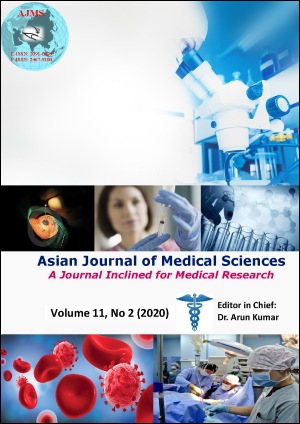Prevalence of dengue virus infection among population of Bhaili visiting tertiary health institution; Chhattisgarh
Keywords:
Prevalence, Dengue, Throbocytopenia, NS1, IgM, IgGAbstract
Background: Dengue fever, dengue haemorrhagic fever and dengue shock syndrome of infection is distinct clinical forms which is caused by Dengue Virus that belong to a member of the Flaviviridae family. It is most important arthropod borne viral disease that causes morbidity and mortality. Dengue virus infection is a major public health problem growing in worldwide and it is estimated about 2.5 billion people of world are at risk of this infection. In India several parts of the country it is an endemic disease.
Aims and Objective: The current work is an attempt to review current perspectives of dengue infection among population of Bhilai visiting tertiary health institution. In study also we have compared the serological profiles of the dengue cases.
Material and Methods: Samples received were performing retrospective analysis in the department of microbiology and process in the departmental microbiology laboratory obtaining during monsoon season. The duration of fever (in days) and other relevant clinical information were recorded from the requisition form. Rapid test for dengue as NS1Ag, IgG and IgM test were performed in accordance with the manufacturer’s instructions. The dengue NS1Ag, IgG and IgM rapid test is an in vitro immunochromatographic test (ICT) which is a onestep assay designed for the qualitative determination of dengue NS1Ag, IgG and IgM in human serum for the diagnosis dengue infection.
Result: During the study period total 1308 serum samples were collected from suspected Dengue fever patients. Among 1308 samples 412(31.5%) samples were found to be positive dengue fever. In the month of August maximum number of sample were received. Out of 1308 patients with dengue suspected patients 792(60.6%) were male and 516(39.4%) were female. Among 60.6% of male 28.2% were positive and out of 39.4% of female 36.6% were positive for dengue. Age between 10-20 years old (55.83%) patients were most affected age group and 70-80 years old (8.77%) age group were least affected. Among the dengue positive patients, dengue parameter associated with thrombocytopenia was also recorded which showed that there was no significant difference between the parameters in relation to thrombocytopenia.
Conclusion: Especially in developing countries like India where there are poor resources for diagnosis of dengue infection, the sensitivity of these tests is more than immunochromatographic Test (ICT). By NS1 assay early detection of dengue infection can help in early confirmation and management of this before its gets complicate. Therefore commercial available dengue NS1 antigen test kits provided additional laboratory diagnostic tool for early detection of dengue.
Downloads
Downloads
Published
How to Cite
Issue
Section
License
Authors who publish with this journal agree to the following terms:
- The journal holds copyright and publishes the work under a Creative Commons CC-BY-NC license that permits use, distribution and reprduction in any medium, provided the original work is properly cited and is not used for commercial purposes. The journal should be recognised as the original publisher of this work.
- Authors are able to enter into separate, additional contractual arrangements for the non-exclusive distribution of the journal's published version of the work (e.g., post it to an institutional repository or publish it in a book), with an acknowledgement of its initial publication in this journal.
- Authors are permitted and encouraged to post their work online (e.g., in institutional repositories or on their website) prior to and during the submission process, as it can lead to productive exchanges, as well as earlier and greater citation of published work (See The Effect of Open Access).




